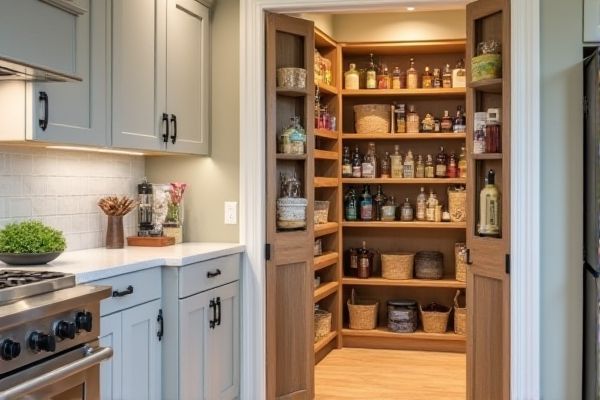
A pull-out pantry maximizes narrow spaces with sliding shelves for easy access, while a reach-in pantry offers traditional shelving with deeper storage capacity. Discover how to choose the best option that fits Your kitchen layout and storage needs by reading the full article.
Table of Comparison
| Feature | Pull-Out Pantry | Reach-In Pantry |
|---|---|---|
| Design | Sliding shelves or drawers within a tall cabinet | Traditional enclosed cupboard or closet space |
| Space Efficiency | Maximizes vertical storage, ideal for narrow spaces | Requires larger footprint, better for wide wall areas |
| Accessibility | Easy to access all items via full extension | Items stored in rear may be harder to reach |
| Installation | Integrated into cabinetry with sliding mechanisms | Simple shelving or built-in closet |
| Storage Capacity | Limited by cabinet height and width | Typically larger, accommodates bulkier items |
| Cost | Generally higher due to hardware and installation | Usually more affordable and easier to install |
| Maintenance | Requires occasional adjustment of sliding parts | Minimal maintenance needed |
| Best For | Small kitchens lacking floor space | Homes with ample kitchen space |
Introduction to Pull-Out and Reach-In Pantries
Pull-out pantries maximize storage efficiency with sliding shelves that provide easy access to items, ideal for narrow spaces and organized kitchens. Reach-in pantries offer deeper storage with traditional shelving, allowing for extensive stockpiling but requiring more effort to reach items at the back. Both pantry types enhance kitchen functionality, with pull-out options emphasizing accessibility and reach-in designs prioritizing volume.
Space Efficiency: Pull-Out vs. Reach-In Pantries
Pull-out pantries maximize space efficiency by utilizing narrow, vertical storage that slides out for easy access, making use of often overlooked gaps in your kitchen layout. Reach-in pantries provide broader storage but require more floor space and can lead to items getting lost in the back, reducing accessibility. Your choice depends on available kitchen dimensions and whether you prioritize compact storage or larger capacity.
Organization and Storage Capacity
Pull-out pantries offer superior organization by utilizing vertical space with sliding shelves, allowing easy access to items and maximizing storage capacity in narrow spaces. Reach-in pantries provide more overall volume with adjustable shelves but can make locating items challenging due to depth and limited visibility. Your choice depends on whether you prioritize efficient use of compact areas or prefer a larger walk-in style for bulk storage.
Accessibility and Ease of Use
Pull-out pantries offer superior accessibility by allowing you to easily slide out shelves, providing full visibility and reach to stored items without bending or stretching. Reach-in pantries typically require more effort to access items at the back, which can lead to clutter and difficulty finding essentials quickly. Your kitchen efficiency improves with a pull-out pantry's user-friendly design, making it easier to organize and retrieve groceries.
Installation Considerations
Pull-out pantries require precise cabinet dimensions and sturdy slide mechanisms to support the weight of stored items, making professional installation advisable for optimal functionality. Reach-in pantries offer more flexible installation options, often involving shelving units or built-in cabinets that can be customized to fit existing wall spaces. Both pantry types demand careful measurement of available kitchen space and consideration of door clearance to ensure ease of access and efficient storage.
Design and Aesthetic Options
Pull-out pantries offer sleek, modern design with concealed storage that maximizes space and maintains a clean kitchen aesthetic, ideal for narrow or compact areas. Reach-in pantries provide versatile shelves and customizable layouts, allowing for personalized organization and an open, accessible design that complements traditional or farmhouse styles. Your choice depends on whether you prioritize streamlined, hidden storage or visible, easily accessible shelving to enhance your kitchen's overall look.
Durability and Maintenance
Pull-out pantries typically feature sturdy metal or wood rails designed for heavy use, improving durability while allowing easy access to stored items, but they may require periodic lubricating and track cleaning to maintain smooth operation. Reach-in pantries often use fixed shelving made from wood or laminate, which can be more susceptible to wear and damage from moisture or spills, necessitating regular cleaning and occasional refinishing to preserve appearance and longevity. Your choice depends on whether you prioritize ease of maintenance or structural resilience in your kitchen storage solution.
Cost Comparison
Pull-out pantries generally cost more than reach-in pantries due to their specialized sliding mechanisms and custom shelving designs. Reach-in pantries offer a more budget-friendly solution, often requiring simpler materials and installation. Homeowners should weigh installation complexity and space efficiency against upfront costs when choosing between the two.
Best Applications for Each Pantry Type
Pull-out pantries are ideal for narrow spaces and kitchens requiring organized, easily accessible storage with sliding shelves that maximize vertical space. Reach-in pantries work best in larger kitchens where ample storage and quick access to a variety of items on fixed shelving are needed. Your choice depends on available space and how efficiently you want to access stored goods.
Choosing the Right Pantry for Your Kitchen Needs
A pull-out pantry maximizes narrow spaces by offering sliding shelves that enhance accessibility and organization in compact kitchens. Reach-in pantries provide more storage capacity with fixed shelving, ideal for larger kitchens needing broad item storage and easy visibility. Selecting between a pull-out and reach-in pantry depends on kitchen size, available space, and specific storage requirements to optimize functionality.
 homyna.com
homyna.com